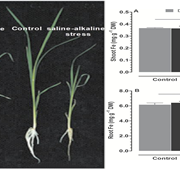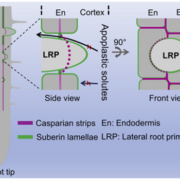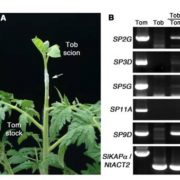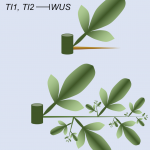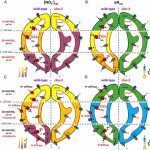MscS-like 10 as a cell swelling sensor and promotes hypo-osmotic shock responses (Curr. Biol.)
 Optimal volume and turgor in the plant cell is important for metabolism, development and growth. Excessive diffusion of water into the cell will cause extreme swelling and a loss of cellular integrity. Members of the plasma membrane MscS-like (MSL) family of mechanosensitive (MS) ion channels play a role in osmotic homeostasis, but their direct function in cell swelling perception and signal transduction have not been determined. Basu and Haswell demonstrated a new assay to investigate cell swelling; the assay involves cell wall softening (through the use of a cellulase synthesis inhibitor) and hypo-osmotic media. Through this, they showed that the MS ion channel MSL10 is a cell swelling sensor and is required for cell swelling responses, using both loss-of-function and gain-of-function alleles. These studies show that in response to cell-swelling, MSL10 promotes cell-swelling induced cell death, increases cytoplasmic calcium and reactive oxygen species (ROS) accumulation, induces gene expression of hypo-osmotic shock-associated genes, and potentiates cell swelling induced programmed cell death (PCD). Interestingly, substitution of the phosphorylation residues at the N-terminal domain of MSL10 to an aspartate phosphomimic residue prevents cell swelling-induced PCD. Overall, this study supports the model of MSL10 as the primary plasma-membrane-based cell swelling sensor and sheds the light for future molecular exploration of the signaling pathway. (Summary by Min May Wong @wongminmay) Curr. Biol. 10.1016/j.cub.2020.05.015
Optimal volume and turgor in the plant cell is important for metabolism, development and growth. Excessive diffusion of water into the cell will cause extreme swelling and a loss of cellular integrity. Members of the plasma membrane MscS-like (MSL) family of mechanosensitive (MS) ion channels play a role in osmotic homeostasis, but their direct function in cell swelling perception and signal transduction have not been determined. Basu and Haswell demonstrated a new assay to investigate cell swelling; the assay involves cell wall softening (through the use of a cellulase synthesis inhibitor) and hypo-osmotic media. Through this, they showed that the MS ion channel MSL10 is a cell swelling sensor and is required for cell swelling responses, using both loss-of-function and gain-of-function alleles. These studies show that in response to cell-swelling, MSL10 promotes cell-swelling induced cell death, increases cytoplasmic calcium and reactive oxygen species (ROS) accumulation, induces gene expression of hypo-osmotic shock-associated genes, and potentiates cell swelling induced programmed cell death (PCD). Interestingly, substitution of the phosphorylation residues at the N-terminal domain of MSL10 to an aspartate phosphomimic residue prevents cell swelling-induced PCD. Overall, this study supports the model of MSL10 as the primary plasma-membrane-based cell swelling sensor and sheds the light for future molecular exploration of the signaling pathway. (Summary by Min May Wong @wongminmay) Curr. Biol. 10.1016/j.cub.2020.05.015


